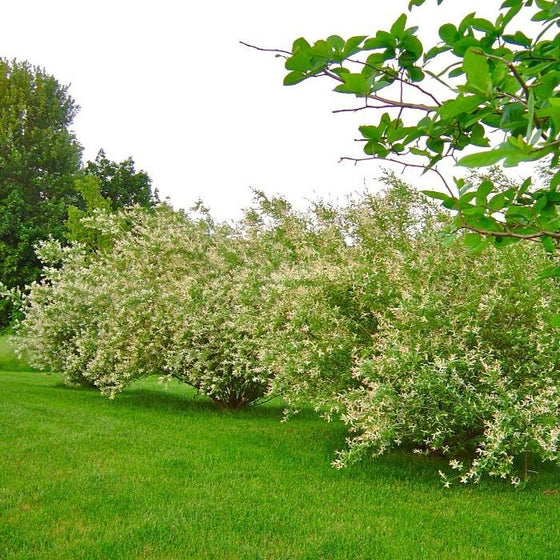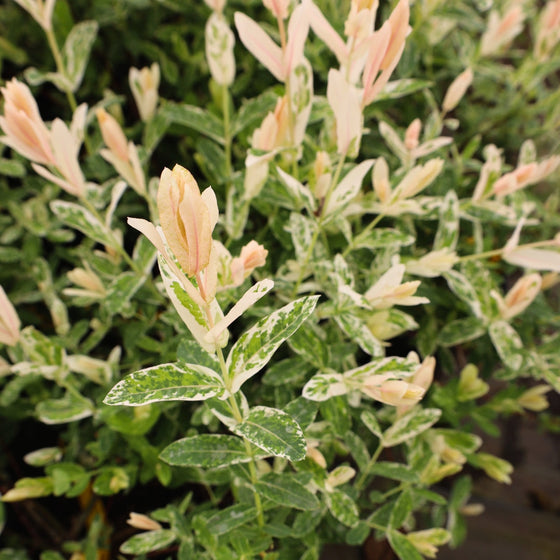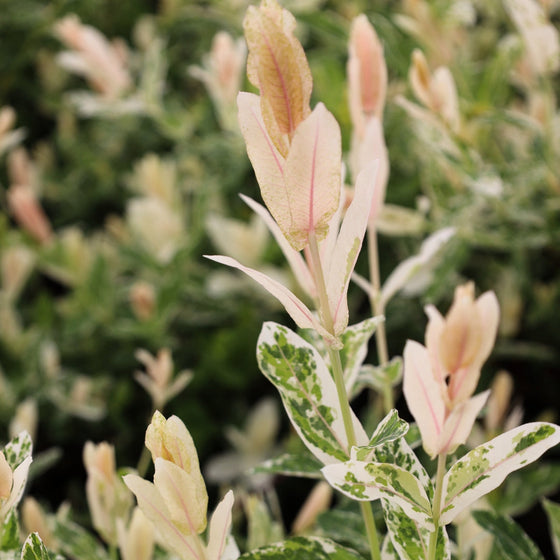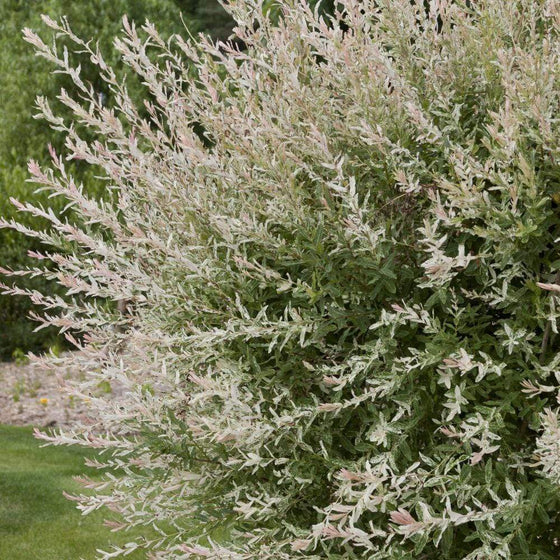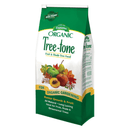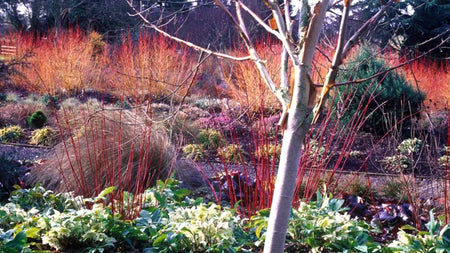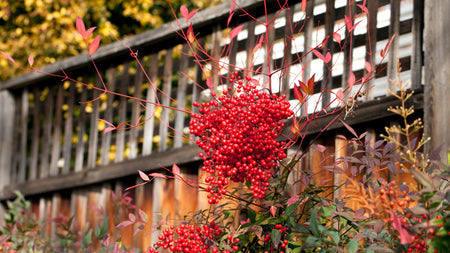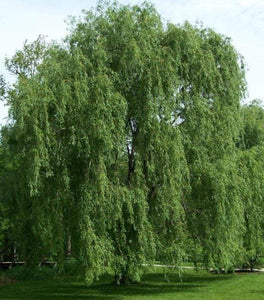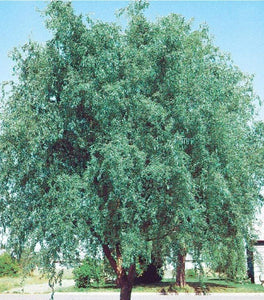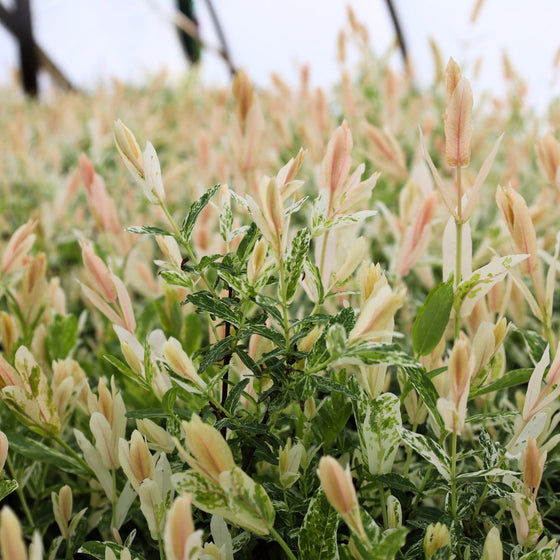
Images Depict Mature Plants
Tri-Colored Dappled Willow Shrubs for Sale Online
Tri-colored Dappled Willow (Salix integra ‘Hakuro Nishiki’) is a striking ornamental shrub known for its vibrant, ever-changing foliage and graceful form. In spring, the new growth emerges with shades of creamy white, soft pink, and bright green, creating a dazzling display that resembles a living watercolor. As the season progresses, the pink fades to reveal variegated white and green leaves that maintain their color and texture through summer. Its arching branches and elegant texture make it a standout focal point or a complementary element in mixed shrub borders, water-wise gardens, or foundation plantings.
Growing 5 to 6 feet tall and wide, Tri-colored Dappled Willow is a fast-growing, low-maintenance shrub that responds well to regular pruning, which enhances its compact form and promotes colorful new growth. It thrives in full sun to part shade and prefers moist, well-drained soil, making it especially useful in rain gardens or along stream banks and low areas in the landscape. This deer-tolerant and adaptable willow is hardy in USDA Zones 4–9, and its versatility makes it ideal for mass plantings, natural screens, or container gardens.
Whether you're looking to add texture to your landscape or brighten a border with brilliant color, Tri-colored Dappled Willow is an exceptional choice for four-season interest. In winter, the plant's red-tinted stems provide subtle structure and contrast against snow or dormant gardens. With its eye-catching variegation, rapid growth, and low maintenance requirements, this ornamental willow is a favorite among homeowners and landscape designers alike for adding dynamic, year-round beauty to any outdoor space.
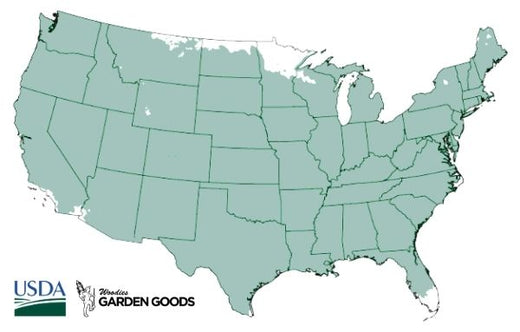
| Hardiness Zone: | 4-9 |
|---|---|
| Mature Height: | 4 to 6 Feet |
| Mature width: | 4 to 6 Feet |
| Classification: | Broad leaved deciduous shrub |
| Sunlight: | Partial to full sun |
| Habit: | Upright and outward |
| Flower Color: | Yellow |
| Foliage: | Green, white, and pink variegation |
| Soil Condition: | Any well drained soil |
| Water Requirements: | Water well until established |
| Uses: | Border, Specimen, Hedge, Woodland Gardens |
How to Care for Tri-colored Dappled Willow
Once you buy a Tri-Colored Dappled Willow shrub, make sure to read about the care instructions that are required and recommended to keep this plant healthy and thriving.
How do I plant a Tri-Colored Dappled Willow?
Planting a Tri-colored Dappled Willow begins with selecting the right location—choose a spot that receives full sun to partial shade, as more sun encourages the most vibrant pink and white foliage. Start by digging a hole twice as wide and just as deep as the root ball. Gently loosen the roots before placing the shrub in the hole, ensuring the top of the root ball sits level with the surrounding soil. Backfill with native soil or a mix of soil and compost to promote drainage and nutrient retention. Water thoroughly after planting to eliminate air pockets and help the roots establish. Space Tri-colored Dappled Willow shrubs 5 to 6 feet apart if planting multiple for a hedge or mass planting, allowing room for their naturally spreading habit. Apply a 2–3 inch layer of mulch around the base, keeping it a few inches from the trunk, to help retain moisture and suppress weeds. These shrubs prefer moist, well-drained soil, making them ideal for low-lying areas, rain gardens, or near water features. With the proper site and care, your Tri-colored Dappled Willow will thrive, offering fast growth, seasonal color changes, and a graceful, elegant form in the landscape.
How do I water a Tri-Colored Dappled Willow Shrub?
Watering your Tri-colored Dappled Willow shrub correctly is essential for healthy establishment and vibrant foliage. During the first growing season, keep the soil consistently moist, watering deeply 2–3 times per week, depending on weather and soil conditions. This ensures the roots develop properly and the colorful new growth flourishes. Tri-colored Dappled Willow thrives in moist, well-drained soil, so it’s especially well-suited for rain gardens, low-lying areas, or near water features. Be cautious not to let the soil dry out completely, especially during hot, dry spells, as this can lead to leaf drop or dull coloration. Once established, the shrub becomes more drought-tolerant, but it will still benefit from regular watering during extended dry periods. A good rule of thumb is to provide about 1 inch of water per week, either through rainfall or irrigation. Applying a 2–3 inch layer of mulch around the base of the plant helps retain moisture, regulate soil temperature, and reduce the frequency of watering. For container-grown Tri-colored Dappled Willow, check soil moisture more frequently, as pots dry out faster than garden beds. With consistent watering, your willow will reward you with lush, variegated foliage and vigorous growth all season long.
How do I Fertilize a Tri-colored Dappled Willow?
Fertilizing your Tri-colored Dappled Willow helps maintain its lush, vibrant foliage and encourages healthy, vigorous growth throughout the season. In early spring, apply a balanced slow-release fertilizer, such as 10-10-10, around the base of the plant just as new growth begins to emerge. Spread the fertilizer evenly at the drip line—where the branches end—and water thoroughly to allow nutrients to absorb into the soil. For an organic option, well-aged compost or a granular organic fertilizer can be incorporated into the topsoil to enrich the root zone naturally. Avoid over-fertilizing, especially with high-nitrogen products, as this may lead to excessive growth at the expense of the shrub’s distinctive pink, white, and green variegated foliage. If your soil is nutrient-poor, a second, lighter feeding in mid-summer can support continued growth and color development. Tri-colored Dappled Willow responds well to routine care, and regular feeding—along with proper watering—ensures the shrub stays healthy, colorful, and beautifully shaped. Whether used in a hedgerow, mixed border, or rain garden, a well-fed willow will become a standout feature in your landscape.

How and When should I Prune my Tri-colored Dappled Willow?
Pruning your Tri-colored Dappled Willow is key to maintaining its compact form, promoting vibrant new growth, and encouraging the beautiful pink and white variegation that makes this shrub a standout. The best time to prune is in late winter to early spring, just before new growth begins. Start by removing any dead, damaged, or crossing branches, then thin out the interior to improve airflow and light penetration. You can also reduce the overall size of the plant by cutting back up to one-third of the branches, which will encourage a flush of colorful new foliage in the spring. For a more formal or compact appearance, you can lightly shear or shape your Tri-colored Dappled Willow again in mid-summer, especially if it’s being used as a hedge or accent shrub. Regular pruning not only enhances the shrub’s color by stimulating new growth, but it also helps manage its fast-growing, spreading habit. Always use clean, sharp pruning tools and avoid pruning in late fall, which could leave the plant vulnerable to winter damage. With a consistent pruning routine, your Tri-colored Dappled Willow will remain a healthy, colorful, and dynamic presence in your landscape year after year.

